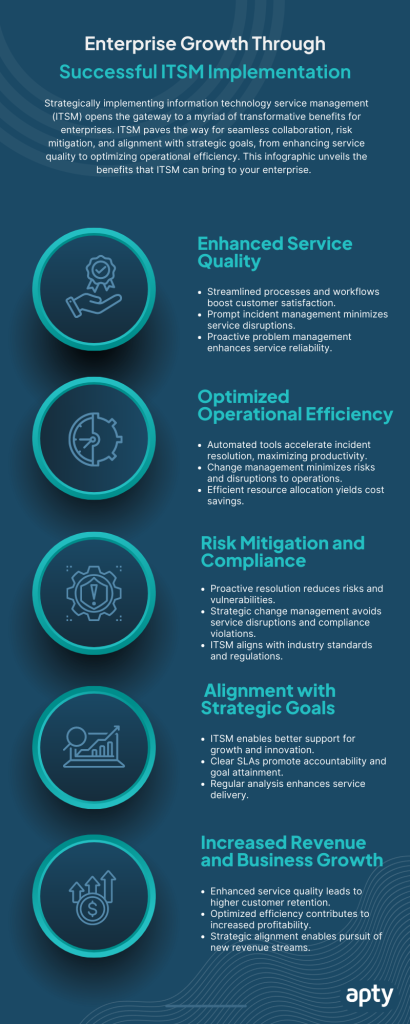ITSM Decoded: Key Processes that Drive Effective IT Service Management
IT Service Management (ITSM) is a strategic approach that focuses on delivering value to the customer through IT services. It facilitates aligning IT services with business needs, improves IT service delivery, reduces costs, and enhances customer satisfaction.
Understanding IT Service Management (ITSM) is essential in today’s digital age, where IT is at the heart of every business. Businesses across industries rely on IT to provide critical services, support business operations, and facilitate digital transformation. The efficiency of the IT service management process is vital to meet customer needs, improve IT service delivery, and reduce costs. Therefore, understanding the four key ITSM processes – Incident Management, Problem Management, Change Management, and Service Level Management – is crucial.
Why ITSM matters
ITSM is more than fixing IT issues; it’s about delivering and managing end-to-end IT services supporting a company’s goals. It’s about ensuring that IT is aligned with the business, that IT services are provided effectively and efficiently, and that disruptions are minimized. In essence, ITSM is about enabling and empowering businesses with IT.
ITSM is not just an operational necessity; it’s a strategic imperative. Effective ITSM can increase efficiency, improve service quality, reduce operating costs, enhance customer satisfaction, manage risk, and enable businesses to adapt quickly to changing business needs.

Given the increasing complexity and demand of IT services, ITSM has become more than just a nice-to-have—it’s a must-have for modern organizations. With its comprehensive processes, ITSM provides a robust framework to meet customer needs, improve IT service delivery, and reduce costs. It’s time for your organization’s buying committee, from the IT department and service desk managers to the IT director and CIO, to consider harnessing the power of ITSM processes. In a world where IT is synonymous with business success, mastering ITSM is an investment that will undoubtedly yield significant returns.
At its core, ITSM involves several key processes. These include Incident Management, Problem Management, Change Management, Service Level Management, and more. Each process contributes to an effective ITSM strategy and helps organizations meet their IT objectives more efficiently.
Incident Management
Incident Management manages IT service interruptions to restore normal service operations quickly. It minimizes disruption and ensures that service quality and availability are maintained.
Reduced Downtime and Service Disruptions
With effective Incident Management, IT professionals can quickly identify and rectify service disruptions, reducing downtime. This ensures smooth IT service delivery and significantly enhances user productivity.
Problem Management
Problem Management is the process of managing the lifecycle of all problems. The primary objective of this process is to prevent incidents and minimize the impact of incidents that cannot be prevented.
Effective Problem Management
Efficient Problem Management helps IT professionals identify recurring incidents and their root causes, leading to better solutions and reduced recurrence of incidents. This results in enhanced service availability and customer satisfaction.
Change Management
Change Management is the process responsible for controlling the lifecycle of all changes. Its primary objective is to enable beneficial changes with minimum disruption to IT services.
Efficient Change Management
By managing changes effectively, IT teams can minimize the risks associated with change failures, ensure timely delivery, and increase the overall success rate of changes.
Learn more: ServiceNow Change Management: The Complete Guide
Service Level Management
Service Level Management involves designing, negotiating, and managing service level agreements (SLAs). It ensures that all service management processes, operational level agreements, and underpinning contracts are appropriate for the agreed service level targets.
Improved IT Service Delivery
Effective Service Level Management ensures that service delivery is consistent and meets the agreed-upon standards. This increases customer satisfaction and trust in the IT services provided by the organization.
Best practices for ITSM processes
Organizations need to follow some best practices to ensure that ITSM processes are effective and efficient.
Best Practices for Incident Management
The incident management process should be well-defined and documented, with clear roles, responsibilities, and escalation procedures. Leveraging a centralized incident management system can help capture, categorize, prioritize, and track incidents. Implementing automated incident detection, notification, and resolution tools can also improve the process’s speed and effectiveness.
Best Practices for Problem Management
Proactive problem management is key. This means identifying potential issues before they cause incidents. Implementing root cause analysis techniques to investigate and diagnose problems is also vital. IT teams should work closely with other stakeholders to identify and implement permanent solutions.
Read more: Best Practices for ServiceNow Implementation
An effective change management process needs a clear workflow that includes change request submission, assessment, approval, planning, and implementation. A Change Advisory Board or management team should review and approve changes based on predefined criteria.
Best Practices for Service Level Management
Establish and document SLAs with clear and measurable targets for service performance, availability, and reliability. Regular monitoring and reporting on service level performance can help ensure SLA compliance.
Learn more: Why Your ITSM Strategy Needs a Digital Adoption Platform for ServiceNow
Optimizing & automating ITSM processes with Digital Adoption Platform
Optimizing and automating IT service management (ITSM) processes can significantly enhance the efficiency and effectiveness of IT operations, resulting in improved service delivery and customer satisfaction. Here are some tips for optimizing and automating ITSM processes:
- Identify and eliminate unnecessary steps: Review each ITSM process to identify any redundant or unnecessary steps that may be causing delays or inefficiencies. Streamline the process by removing such steps and optimizing the workflow to minimize unnecessary complexities. DAPs can guide end-users through complex ITSM processes, offering in-app guidance and interactive tutorials. This makes it easier for users to adopt new processes and identifies and eliminates unnecessary steps.
- Leverage automation tools: Utilize automation tools, such as workflow automation, robotic process automation (RPA), and artificial intelligence (AI), to automate repetitive and manual tasks in ITSM processes. Automation can reduce human errors, speed up processes, and free up IT staff to focus on more strategic tasks. DAPs can be integrated with automation tools like RPA and AI to streamline repetitive tasks and automate manual processes in ITSM. This can result in increased process efficiency, reduced error rates, and more strategic use of IT staff.
- Implement self-service options: Provide self-service options to end-users, such as self-service portals or chatbots, to enable them to access IT services and resolve common issues independently. This can reduce the workload on IT teams and improve end-user satisfaction. DAPs can provide self-service training to users, allowing them to learn and adapt to new ITSM processes at their own pace. This reduces the need for formal training and allows IT teams to focus on more strategic tasks.
- Establish standard operating procedures (SOPs): Define and document standard operating procedures (SOPs) for each ITSM process to ensure consistency and efficiency. SOPs provide clear guidelines for IT staff to follow and minimize variations in operations. DAPs can enforce standard operating procedures (SOPs) by guiding users through the correct steps and processes. This ensures consistency and efficiency in executing ITSM processes.
- Monitor and measure performance: Implement metrics and Key Performance Indicators (KPIs) to measure the performance of ITSM processes. Regularly monitor and analyze the data to identify areas for improvement and take necessary actions to optimize the processes further. DAPs have built-in analytics features that measure user engagement, learning progress, and other performance indicators. These insights can help identify areas for improvement in ITSM processes and optimize them accordingly.
- Foster collaboration and communication: Encourage collaboration and communication among IT teams to streamline ITSM processes. Foster a culture of teamwork and knowledge sharing and utilize collaborative tools like chat platforms or project management tools to facilitate effective communication and coordination. DAPs can be integrated with collaboration tools to facilitate effective communication and teamwork among IT staff. This can enhance knowledge sharing and streamline ITSM processes.
- Continuously review and improve: ITSM processes should be constantly reviewed and improved to keep up with changing business needs and technological advancements. Regularly assess the effectiveness of ITSM processes, gather feedback from stakeholders, and implement improvements to optimize and automate the processes further. DAPs provide real-time feedback and insights into user behavior and process performance. This allows organizations to continually assess and improve their ITSM processes to keep up with changing needs and technological advancements.
Key Value Drivers in IT Service Management
- Reduced downtime and service disruptions: ITSM allows swift service restoration following an incident or disruption, thereby reducing downtime and potential losses. DAP can automate processes and tasks, reducing the chances of human error, which is often a leading cause of downtime. In addition, it can help with the quicker adoption of new technologies and changes, reducing potential disruptions.
- Improved incident management and resolution: ITSM helps streamline the incident management process, facilitating faster resolution and minimizing the negative impact on business operations. DAP can streamline incident management processes by offering on-demand, in-app guidance to IT service desk agents. It can also offer proactive assistance to users to help them resolve common issues independently, reducing the number of incidents.
- Enhanced service availability: Through proactive management and maintenance of IT services and infrastructure, ITSM helps enhance service availability, resulting in smoother business operations. Using analytics to monitor user behavior and identify common issues, DAP allows organizations to proactively address potential disruptions before they occur, enhancing service availability.
- Increased customer satisfaction with IT services: With improved service availability and incident resolution, customer satisfaction with IT services increases significantly. DAP can improve customer satisfaction by enabling more efficient and effective use of IT services. It provides Contextual in-app guides and proactive support to help users navigate and use applications more easily.
- Efficient change management: ITSM enables controlled and coordinated changes in the IT infrastructure and services, ensuring a seamless transition and reducing the chances of service disruption. With DAP, organizations can better manage change. It can help facilitate seamless transitions by providing in-app, step-by-step guidance when changes are made to applications or processes.
- Streamlined service request handling: ITSM standardizes the process of handling service requests, resulting in faster and more efficient service delivery. DAP can help streamline service request processes by offering users in-app step-by-step guidance to correctly fill out service request forms, reducing the need for back-and-forth communication and expediting request resolution.
- Effective problem management: By identifying and addressing the root cause of incidents, ITSM helps improve problem management, leading to fewer recurring incidents. DAP can assist in problem management by enabling faster identification of recurring issues and trends through its comprehensive analytics capabilities.
- Better asset and configuration management: ITSM provides tools and processes for better management of IT assets and configurations, which helps reduce costs and improve service delivery. DAP’s analytics can provide insights into how different assets are used and interact with each other, helping with more efficient asset and configuration management.
- Proactive monitoring and alerts: ITSM enables proactive monitoring of IT services and infrastructure, helping to identify and resolve potential issues before they escalate into significant incidents. DAP can provide real-time insights into user behavior and application performance, enabling IT teams to identify potential issues and take preventive measures proactively.
- Improved IT service delivery: Overall, ITSM enhances IT service delivery by ensuring that IT services are aligned with business objectives and effectively meet users’ needs. DAP can significantly improve the overall delivery of IT services by improving the adoption of IT services and enabling users to use them more effectively.
Learn more: ServiceNow Change Management: The Complete Guide
Why Apty for your ITSM strategy
Adopting and implementing IT Service Management (ITSM) processes are crucial to managing IT as a service rather than a disjointed series of technical components. With a well-defined ITSM strategy, organizations can better meet customer needs, improve service delivery, and manage costs more effectively.
However, as businesses increasingly rely on technology to conduct their operations, the complexities of managing IT services have amplified. From handling routine tasks to resolving high-level issues, IT service teams navigate an intricate landscape of tasks, workflows, and user requirements.
This is where the role of a Digital Adoption Platform (DAP) like Apty becomes a game-changer. DAPs don’t just resolve the symptoms of ITSM inefficiencies; they target the root causes. Whether it’s reducing downtime, managing changes, streamlining service requests, or improving overall IT service delivery, DAPs enhance ITSM processes’ efficiency and effectiveness.
With the right DAP in place, businesses can equip themselves better to tackle the complexities of IT services, reduce friction, improve productivity, and deliver superior service quality that aligns with the organization’s overall business goals. In the ever-evolving digital age, incorporating a DAP into your ITSM strategy is not merely an option; it’s a necessity.
Table of Contents
- ITSM Decoded: Key Processes that Drive Effective IT Service Management
- Why ITSM matters
- Incident Management
- Reduced Downtime and Service Disruptions
- Problem Management
- Effective Problem Management
- Change Management
- Efficient Change Management
- Service Level Management
- Improved IT Service Delivery
- Best practices for ITSM processes
- Best Practices for Incident Management
- Best Practices for Problem Management
- Best Practices for Service Level Management
- Optimizing & automating ITSM processes with Digital Adoption Platform
- Key Value Drivers in IT Service Management
- Why Apty for your ITSM strategy
- Streamline your ITSM processes with Apty
- Oracle HCM Implementation: Steps & Best Practices 2025
- ERP Implementation: Steps, Challenges & Best Practices
- 9 Change Management Strategies for Smooth Transitions





